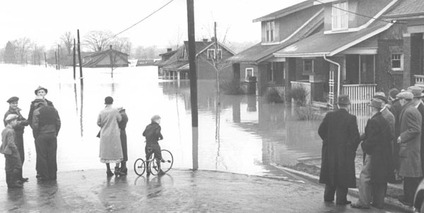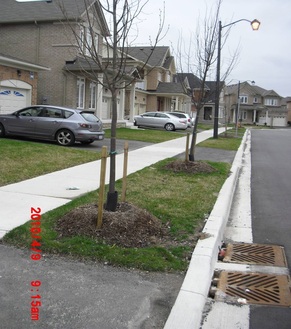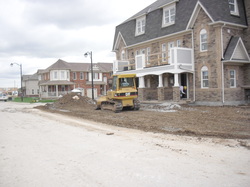Ontario has been in a similar position before...

Thames River Flooding, London ON 1937
Deforestation throughout the 1800's and into the 1900's resulted in severe soil erosion, droughts, floods and devastating ecological damage. A loss of the natural services provided by the environment created conditions which would have been naturally buffered and gone unnoticed. These had significant negative impacts on the economy and society during this period.
A few visionaries who understood the natural processes of our environment undertook what is to this day the greatest erosion control project in the province. Reforestation. The planting of Red and White Pine on what had become vast areas of soilless sand and rock by Edmund Zavitz and other like-minded folks helped restore and protect the headwaters of many of Southern Ontario's major rivers. This was a monumental effort over a hundred year period and truly a significant example of the importance of Green Infrastructure.
The parallels between this earlier time period in Ontario's history and the present are obvious. Flooding, drought, erosion and degradation of natural water courses and water quality are the very same issues we face today. The modern economic cost associated with this comes in the form of maintenance, repair and pre-mature replacement of stormwater and street infrastructure along with stream and river restoration costs which are presently accelerating. This largely brought about by urbanization and its associated development practices which have not recognized the services provided by green infrastructure. The result is with each development a municipality assumes, comes chronic maintenance and environmental costs which will never be effectively resolved. And with each future development coming on-line, will come future costs. The majority of this is preventable and application of LID designs and practices in future development standards can reduce these social, economic and environmental costs.
A few visionaries who understood the natural processes of our environment undertook what is to this day the greatest erosion control project in the province. Reforestation. The planting of Red and White Pine on what had become vast areas of soilless sand and rock by Edmund Zavitz and other like-minded folks helped restore and protect the headwaters of many of Southern Ontario's major rivers. This was a monumental effort over a hundred year period and truly a significant example of the importance of Green Infrastructure.
The parallels between this earlier time period in Ontario's history and the present are obvious. Flooding, drought, erosion and degradation of natural water courses and water quality are the very same issues we face today. The modern economic cost associated with this comes in the form of maintenance, repair and pre-mature replacement of stormwater and street infrastructure along with stream and river restoration costs which are presently accelerating. This largely brought about by urbanization and its associated development practices which have not recognized the services provided by green infrastructure. The result is with each development a municipality assumes, comes chronic maintenance and environmental costs which will never be effectively resolved. And with each future development coming on-line, will come future costs. The majority of this is preventable and application of LID designs and practices in future development standards can reduce these social, economic and environmental costs.
Early Urbanization

Fergus ON
The development of urban centers in Ontario up to about 1950 was done on a scale of one building at a time to one street at a time. The means of transporting fill and topsoil from excavations was limited resulting in most of this material remaining in the general facinity of the construction site. While these materials would often end up mixed together, they were re-applied and used locally. The limited amount of handling and their local use produced soils which were relatively pervious and a good growing media for trees and vegetation. Most pre 1950 neighbourhoods in towns and cities exhibit good urban tree cover and landscapes because of the limited (relatively) disruptions to these sites during their construction.
1950 to Present - (Suburbia)

Halton Region 2010
Post World War Two took advantage of technologies development for the war such as tracked vehicles and larger diesel powered construction equipment and trucks. It became possible to develop an entire neighbourhood at one time. Mass grading became the common practice. Major changes to site hydrology occurred since all trees and vegetative cover was stripped along with all topsoil. Sub-soil (fill) was added or removed to suit the grading plan and compacted to a level previously not possible. Topsoil which was either completely removed from the site or stockpiled often several stories high was re-applied and seeded, sodded and planted after building construction was complete. This has occurred for 60 years creating vast urban areas we refer to as suburbia.
Cut, Fill and Compact.......................Fine Grade...................................... Topsoil and Landscape

What services will these trees, turf and soil provide 40 years from now?

This landscaped site contains:
• Compacted fill
• “A” gravel
• Screenings
• Concrete washout
• Anaerobic topsoil
• 1% – 2% organic matter
• Compaction levels approaching 2 g/cm³
This landscape is considered to be as pervious as it was prior to development. It is not. These site conditions will not sustain this landscape to maturity and the natural assets and all the benefits they provide may be lost overtime at great cost economically, environmentally and socially. This is the legacy of suburbia.
• Compacted fill
• “A” gravel
• Screenings
• Concrete washout
• Anaerobic topsoil
• 1% – 2% organic matter
• Compaction levels approaching 2 g/cm³
This landscape is considered to be as pervious as it was prior to development. It is not. These site conditions will not sustain this landscape to maturity and the natural assets and all the benefits they provide may be lost overtime at great cost economically, environmentally and socially. This is the legacy of suburbia.
So what's the point?

City of Vaughan 2006, TRCA
It is relatively recently that we understood the cumulative effect of this style of development on our environment and economy. The 1980's brought new stormwater management designs incorporating stormwater detention ponds and more recently the use of engineered wetlands to deal with an ever increasing volume of water and a reduction in its quality. However, cumulative effect of development has proven greater than our engineered solutions to date.
Some thoughts: philosophical and scientific

The land development process while about constructing, is also about de-constructing. In order to add man-made infrastructure (buildings, roads, storm drains etc), we must first dis-assemble the existing landscape, be it natural, rural or green urban spaces or replacements of existing developments. This process eliminates the natural services involved in hydrology. These services are not adequately replaced by the services of man-made infrastructure. Many years later, we find ourselves having to modify our developmental behaviour in order to counter past ignorance of this fact. Most of this is not intentional, but largely preventable.
The science behind successful urban development was understood in Roman times, they de-forested, learned from it and re-forested. The same rules that govern our part of the planet in our time frame are no different. So what did we miss here? How is it that we buy into our standard construction practices by day, yet go home and tend to our family's prized magnificent backyard garden? This is not an unfair question. Gardens come in all sizes be it backyard or planet sized. The laws of nature apply universally. While this may be viewed as a philosophical discussion, it is far from it. Nature does not judge good or bad, it just is. We can chose to maximize its benefits or we can choose not to (on purpose or by ignorance) and receive the consequences. History has proven the worth of applying nature or mimicking it as best able to ease economic, social and environmental challenges. The triple bottom line (social, economic, environmental) has always been relevant. As important as one is, so are each of the others. This is of course a human perspective as the environment would be just fine without the social/economic components which only apply to humans.
The science behind successful urban development was understood in Roman times, they de-forested, learned from it and re-forested. The same rules that govern our part of the planet in our time frame are no different. So what did we miss here? How is it that we buy into our standard construction practices by day, yet go home and tend to our family's prized magnificent backyard garden? This is not an unfair question. Gardens come in all sizes be it backyard or planet sized. The laws of nature apply universally. While this may be viewed as a philosophical discussion, it is far from it. Nature does not judge good or bad, it just is. We can chose to maximize its benefits or we can choose not to (on purpose or by ignorance) and receive the consequences. History has proven the worth of applying nature or mimicking it as best able to ease economic, social and environmental challenges. The triple bottom line (social, economic, environmental) has always been relevant. As important as one is, so are each of the others. This is of course a human perspective as the environment would be just fine without the social/economic components which only apply to humans.
